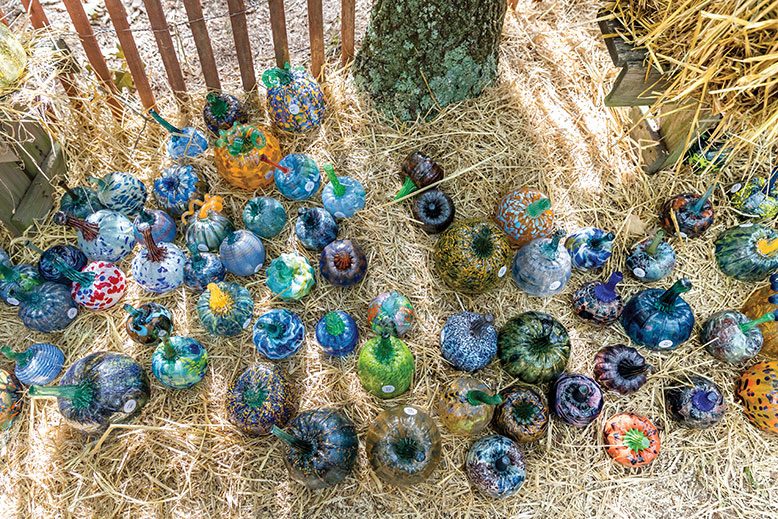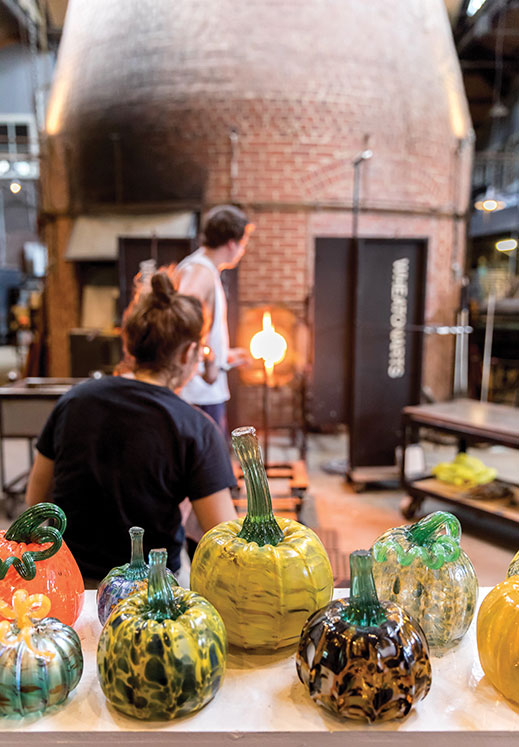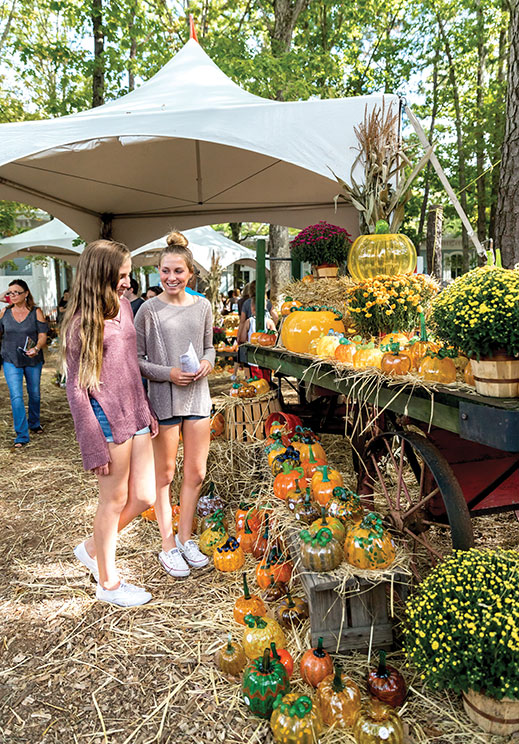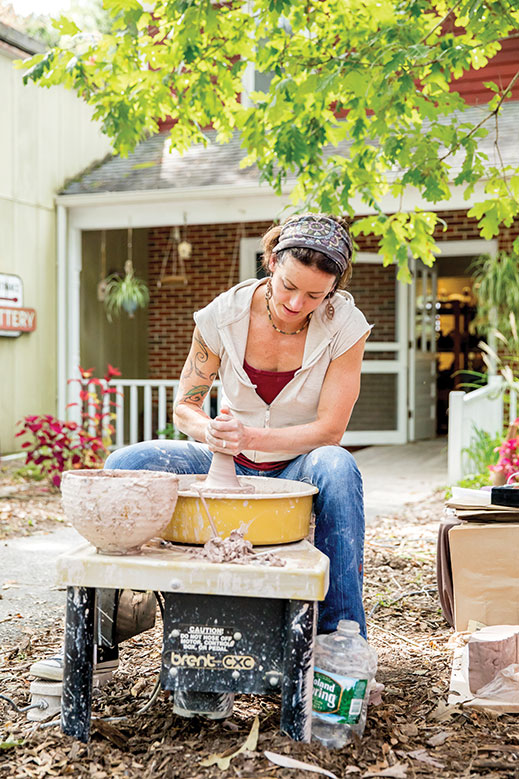
The 7,000 pumpkins on display at the WheatonArts Festival of Fine Craft don’t grow on vines. Some have blue, curled stems that look like gift ribbon. Others are shimmery, with orange and green speckles. They aren’t painted, either. They’re made of glass.
WheatonArts and Cultural Center is a cluster of buildings spread across 45 wooded acres that were once at the center of the nation’s earliest glass industry. With a history dating back almost 50 years, the facility in Millville houses the beautifully curated Museum of American Glass, interactive artist studios, and gift shops featuring locally made art pieces. The Festival of Fine Craft, the nonprofit’s largest annual event, attracts approximately 10,000 people. This year’s 20th edition is planned for October 6-7.

Glassblowing interns Madeline Almeida and Mike Jess demonstrate in the glass studio at WheatonArts at last year’s Festival of Fine Craft. Photo by Jessica Orlowicz
To prepare for the glass pumpkin patch—a crowd favorite that first sprouted in 2009—WheatonArts glassblowers work four days a week for four to five months, churning out about 60 to 120 glass pumpkins of various sizes and colors each day.
The process begins in a furnace full of molten glass set to 2,000-2,400 degrees Fahrenheit. A gaffer, the most experienced glassblower who dictates the pace and responsibilities, and two assistants work as a team to make one pumpkin at a time. Glass from the furnace is gathered on the end of a blowpipe (a long metal straw) and color is applied. The bubble is introduced by blowing into one end of the rod. Then it is stamped in a mold to create ribbing. As the glass inflates, the blowpipe must be continuously rotated. “It’s a viscous material. So if you stop turning, gravity takes over,” says Skitch Manion, the glass-studio manager who began glassblowing when he was 10. Once it’s a bulbous shape, the piece is knocked off the blowpipe, and the stem is applied. Soon, it will be taken to the 900-degree annealing oven to cool down.
“Within those steps, there’s probably hundreds of other little things that have to happen,” says Manion. Significant skill is required to turn out pumpkins quickly. “It’s like free throws in basketball,” he says. “Anybody can do one, but the really good basketball players can do dozens in a row.”
Beyond the glass pumpkin patch, there’s much to see at the festival, including 150 juried artists’ booths. “The goal [of the festival] is to expose this wonderful work and these wonderful artists to the public,” says Cathy Nolan, chief operating officer for WheatonArts and Cultural Center. “It’s one of the best craft festivals on the East Coast,” she adds. Other happenings include live music, a beer-and-wine garden, and children’s activities, such as scarecrow building, pendulum painting, bead making and creating mosaic rocks.

Sisters Gwen and Bella Orlowicz admire some of the 7,000 glass pumpkins in the patch. Photo by Jessica Orlowicz
In addition to glass, the juried artists work in metal, leather, fiber, clay, wood and other materials. “We try to make sure that we represent a broad swath of the handmade,” says Nolan.
Pauletta Berger, an exhibiting fiber artist at the festival since 1999, learned to weave at WheatonArts. Now, she brings her loom to festivals to demonstrate her craft. “The best way for people to understand and appreciate what I do is to actually see the weaving process,” she says.
There are many opportunities for visitors to see glassblowing, flame working, pottery and more in action at the festival.
Ruthie Lindberg of Vineland, who visited last year’s celebration with her husband Stuart, watched glass artists create a vessel from beginning to end. “Just making the piece was like a performance itself,” she says. “We were so engrossed, we couldn’t leave until it was finished.”
Indeed, glassmaking requires choreography and extreme focus.
“It’s not a process that lends itself to absentmindedness,” says Manion. “It takes a tremendous amount of time to become comfortable with the material.”
Glassblowing is at least 5,000 years old. Some of the 20,000 pieces in the Museum of American Glass date to the 1700s.
“We’re unique because we’re a place of creation and display,” says Kristin Qualls, director of exhibitions and collections. During this year’s festival, there will be two contemporary art exhibits in the museum. “Symbiotic Spheres: The Interlocking Worlds of Glass, Science and Art” will feature 28 artists whose work is inspired by science. “Beauty Beyond Nature: The Glass Art of Paul Stankard” will showcase the work of the Mantua-based Stankard, an internationally renowned glass artist.

Resident potter Erika Pugh crafts a piece on her pottery wheel outside the ceramic studio. Photo by Jessica Orlowicz
Artists from around the world come to work at WheatonArts. Through the Creative Glass fellowship, up to 10 glassblowers are artists in residence each year. Their work and that of WheatonArts resident artists—including the glass pumpkins—is on sale at the festival.
“History is being created everyday in glass with the artists and the interactions with the public,” says Nolan. She notes that WheatonArts is not a living-history destination; the staff, she says, are working artists.
“There’s not many places where you can interact with people who are making their living as artists,” says Nolan. “[Our] goal is always to advance and promote the artists and the handmade work for people to understand it and the quality of it.”



